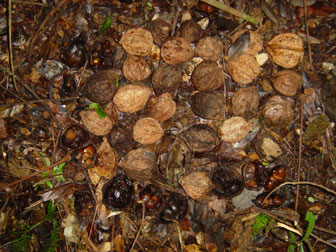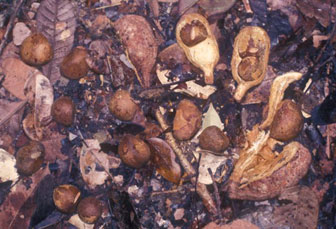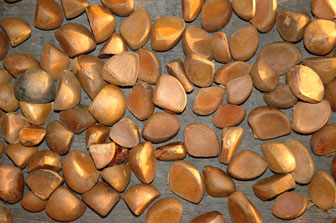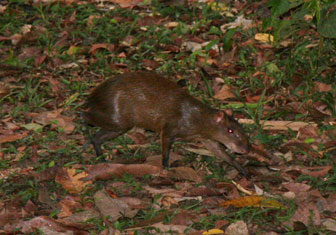Are Brazil nuts really sustainable?
Only if hunting is controlled
A lot of rainforest conservation initiatives embrace sustainably harvested non-timber forest products (NTFPs) like seeds and nuts as a means to provide income to locals without harming the forest. Operating on the premise that such products are eco-friendly, hundreds of outfits ranging from Whole Foods to the Body Shop to Ben & Jerry’s Homemade Ice Cream tout their use of sustainably harvested Brazil nuts and related products. But really, how sustainable are these products?
A study published in the February 2007 issue of the journal Conservation Biology suggests that nuts and seeds from the rainforest are indeed sustainable, but only when hunting of key seed dispersers — especially large rodents like agouti and acouchy — is limited. In places where subsistence hunting accompanies seed extraction, the ability of NTFP tree species to propagate is reduced, putting the whole harvesting scheme at risk. The study shows the importance of seed disperser conservation in sustainably managed forest areas.
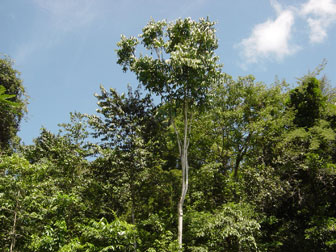
|
Examining Carapa procera seed dispersal by rodents in French Guiana and Suriname, Pierre-Michel Forget of the Museum National d’Histoire Naturelle in France and Patrick A. Jansen of Wageningen University in the Netherlands found that hunting reduces the viability of NTFP harvesting.
In Latin American forests, Carapa depends on large rodents
Carapa procera, the seeds of which are used to produce an oil nontimber forest product used medicinally for skin ailments, is dependent on dispersal by “scatter-hoarding” rodents, specifically the red acouchy (Myoprocta acouchy) and the red-rumped agouti (Dasyprocta leporina). As described by Forget and Jansen in their paper, these rodents disperse the seeds by collecting them “one by one from below parent trees and burying these as food reserves in shallow caches at distances up to 125 m from the tree, each seed at a different spot.” While the rodents feed heavily on these caches during the lean dry season, some seeds are invariably forgotten and germinate into seedlings, ensuring the next generation of Carapa trees. Seeds that are not quickly dispersed by rodents rot under the parent tree or become infested with insects. As such, the rodents play a key role in the life cycle of the tree species.
Given the significance of the rodent population, Forget and Jansen wanted to see the impact of hunting on the propagation of the Carapa trees. Using four study sites in French Guiana and Suriname, each with protected and hunted rodent populations, the scientists found that hunted areas had a lower proportion of seeds dispersed than in protected areas, indicating reduced likelihood that seeds would germinate and become seedlings. The findings are consistent with other studies that show hunting reduces dispersal rates among other tree species.
The problem that arises is when subsistence hunting accompanies seed extraction. In many areas, wild game is a key supplemental source of protein for human populations living in and around forest areas where seeds and nuts are harvested.
“The sustainability of natural non-timber forest products on the international market is a topic of hot debate,” said Forget, who has spent more than 20 years studying the relationships between plants and animal dispersers. “We need to be careful when purchasing and using natural products from the Amazonian forest, as well as other areas. These seeds and nuts are part of the natural cycle. Seeds naturally lost to rodents (predation following seed dispersal) are the price to pay to for efficient propagation of the tree species. When human harvest all seeds to maximize income, rodents might suffer or put greater pressure on other seed species, thus threatening biodiversity as a whole.”
“In the short term, trees lose seedlings. Over the long term, human communities might lose their sustainable livelihood as less NTFP trees germinate and reach maturity,” Forget told mongabay.com. “Andiroba or crabwood oil is a major income for local communities but overharvesting of game (rodents such as agouti and acouchy) may also preclude efficient recruitment. The situation might be even worse when seeds are, at the same time, harvested for oil production.”
While over-harvesting of seeds can be a problem for seed dispersers and hence overall forest health, the authors say that seed extraction in moderation can actually be beneficial to the forest ecosystem and human inhabitants, especially in years with a bumper seed crop. The reasoning? Since undispersed seeds have a low probability of sprouting and generally not collected by seed dispersers which prefer freshly fallen seeds, their commercial extraction does not necessarily hurt disperser populations or affect the overall number of seedlings.
“Ironically, because undispersed seeds have a negligible probability of recruitment, their commercial extraction need not negatively affect seedling recruitment further,” wrote the authors. “Extraction of undispersed seeds might even promote recruitment, given that accumulations of seeds below parent trees facilitate a buildup of seed-predating insect populations and may result in increasing seed predation over time.”
“In contrast,” added Forget, “in lean years the entire crop of seeds might be just enough to feed rodents and no extra seeds might be invested in the regeneration of the tree species, as shown by the doctoral thesis of Patrick Jansen. In such years, seed extraction might be detrimental to rodent survival on the short term, and to tree regeneration on the long term.”
 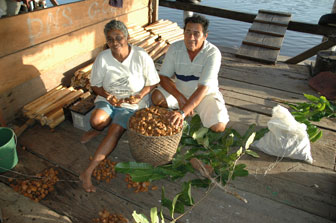
Andiroba oil (imported from Brazil) for sale in Cayenne, the prefecture of French Guiana (top). In Guyana, Carapa oil is produced by Maria and Terry Gonsalves for a sea turtle conservation project (bottom). GMTCS is working along with Iwokrama to develop an international market for carapa oil. Photos courtesy of Dr. Pierre-Michel Forget. |
Forget and Jansen say that hunting undermines the whole concept of sustainability in seed harvesting.
“The subsistence hunting that usually accompanies seed extraction is at the cost of seed dispersal and may contribute to recruitment failure of these NTFPs,” they wrote. “Seed extraction from natural populations may less affect seedling recruitment and therefore be more sustainable if accompanied by measures adequately incorporating and protecting seed dispersers.”
“Given the importance of animals (frugivores) for forest regeneration, we need to find a good balance between all those different uses (game hunting and seeds/fruits) in parks and reserves,” said Forget. “The best solution may be to encourage the development of diverse multi-species plantations of these NTFP trees on degraded lands… This may help save rainforests in South America and other parts of the world.”
Further reading
Nontimber forest products are also known as non-wood forest products (NWFP).
